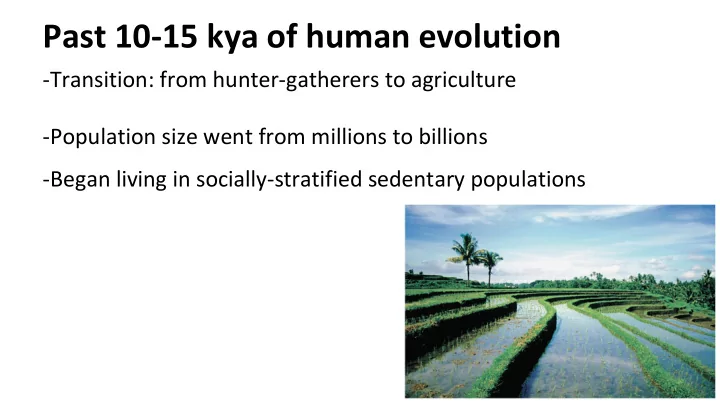

Past 10-15 kya of human evolution -Transition: from hunter-gatherers to agriculture -Population size went from millions to billions -Began living in socially-stratified sedentary populations 1
Past 10-15 kya of human evolution Sedentism: living in large, stationary communities Domestication: converting wild plants/animals into forms humans can cultivate 2
Our evolutionary history affects us today Modern humans: highly-generalized; behaviorally flexible Maladaptations: adaptations benefitting our ancestors create health, diet, and lifestyle challenges today Ex. Ability to store fat 3
Our evolutionary history affects us today Nutritional adaptations: drastic changes to diet in the last 10 ky Preagricultural diet -More variation in foods but uncertain access - High: animal protein, complex carbs, and calcium - Low: saturated fat and salt 4
Our evolutionary history affects us today Modern diet -Stable access to food but reduced variety of food types - High: saturated fat, simple carbs, sugar, and sodium Nutritional deficiency diseases -Disorders associated with obesity Ex. Type II diabetes -Reduced/poor diet combined with infrequent exercise make past nutritional adaptations maladaptive 5
Life cycle stages -Human life cycle stages = nonhuman primates but with added complexity -Stages are marked by biological transitions Ex. Birth and puberty 6
Aging Senescence: decline in physiological functioning (aging) -Relatively longer lifespan -Humans living longer today due to increased standards of living 7
Biological transitions between stages are culturally marked -Marked by ritual/celebration -Change in social status Ex. Menarche: girl's first menstruation Ex. Menopause: end of menstruation in women over 50 8
Life-cycle stages in humans -Only humans have childhood and postreproductive stage 9
Life-cycle stages in unique to humans Childhood: stage between weaning and puberty -Uniquely long in humans -Key to learning in humans -Brain develops in stimulating cultural context Post-reproductive stage Grandmother hypothesis: postmenopausal females provide high-quality care for grandchildren 10
Can we predict future human evolution? Question: What will humans look like in a thousand years? Answer: Probably the same … Question: What will humans look like in a million years? Answer: I do not know. Do know: -Biological constraints -History of all life on Earth... 11
Human population growth -Our increasing population impacts the planet the most 12
Ch. 14 13
The future of human evolution? 14
Global warming impact sourced to humans -Dramatic climatic changes caused by increased greenhouse gases in the atmosphere heat up the Earth Fossil fuels release CO2 which traps heat Acidification of oceans from excess CO2 decreases pH levels Deforestation reduces excess CO2 absorption 15
Climate change and humans Scientific consensus -Global warming occurs -Human activity contributes to it Human increasing population size -Most important reason our impact on the planet has been so great 16
Human population growth -Our increasing populations impacts the planet the most 17
Effects of global climate change -Rising sea levels -Extinction of plants and animals -Infectious diseases increase (malaria, dengue, and yellow fever) Ex. temperature increase results in mosquito population increase 18
Solutions to global warming -Adopt more fuel-efficient technologies -International cooperation Conservation Ex. Ecotourism in Costa Rica = generates income and preserves forests reducing negative impact on environments 19
Recommend
More recommend